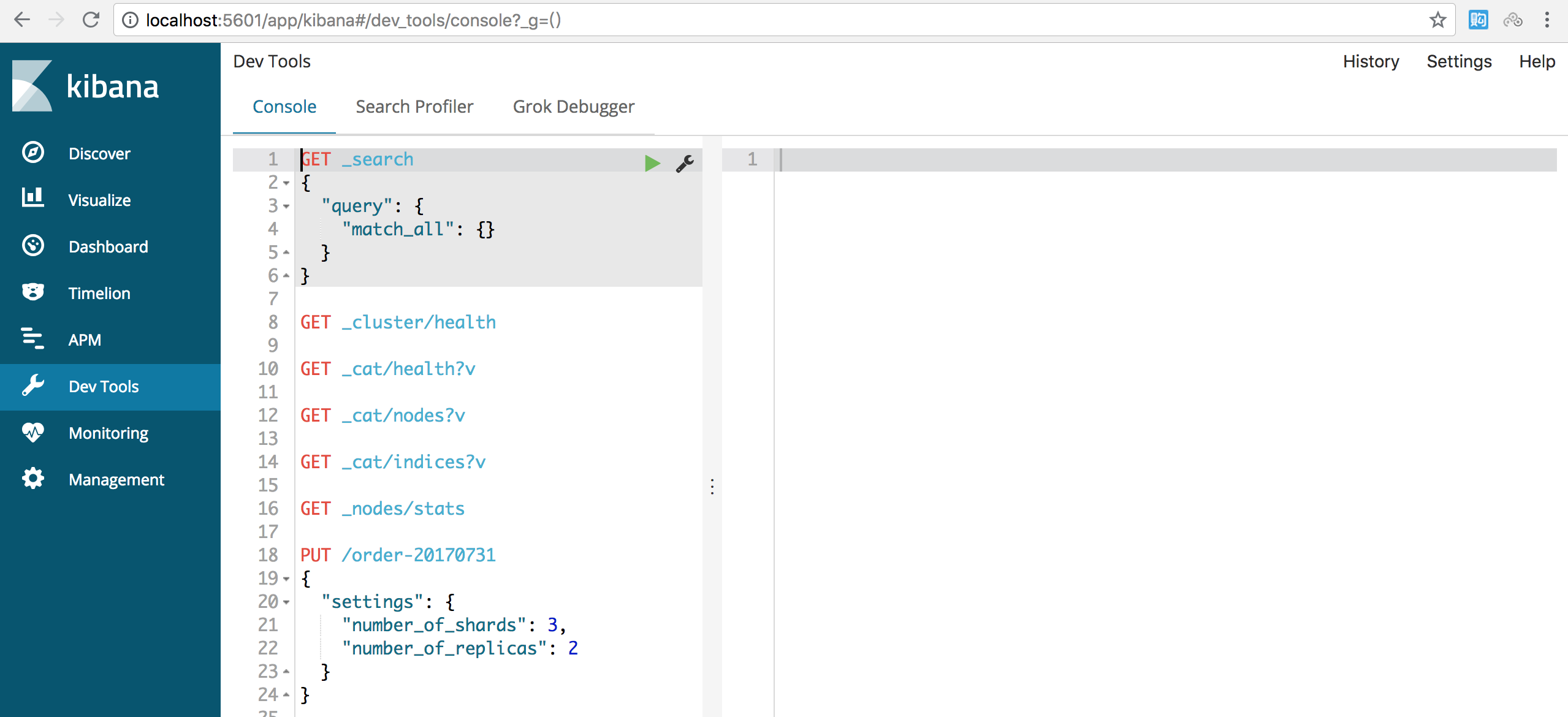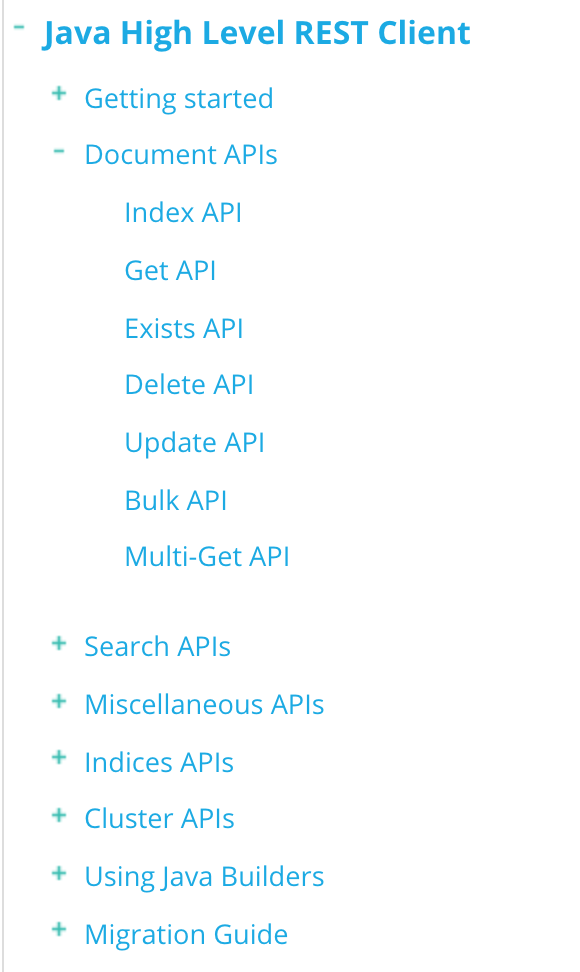本次博文发两块,前部分是怎样搭建一个Elastic集群,后半部分是基于Java对数据进行写入和聚合统计。
一、Elastic集群搭建
1. 环境准备。
该集群环境基于VMware虚拟机、CentOS 7系统,公司目前用的服务器系统基本全是CentOS系统,因此就选了这个。Elasticsearch需要依赖的最低环境就是JDK8,且要配置好环境变量JAVA_HOME. Elasticsearch的安装也可以查看官网给出的安装说明。
虚拟机系统采用的是最小化安装,没有安装桌面程序。安装完程序再安装JDK,配置环境变量即可。
2. 集群搭建。
2.1 安装包解压
下载完成后的Elastic包为elasticsearch-6.3.2.tar.gz,对其解压。
# 将elastic包加压到目录 /data/elastic 下 tar zxvf elasticsearch-6.3.2.tar.gz -C /data/elastic
2.2 配置文件修改
解压后的路径为/data/elastic/elasticsearch-6.3.2,在/data/elastic目录下新增两个文件夹,为data,logs,其中data用来存储节点数据,logs用来存储日志,下面在修改配置文件中需要用到。修改config/elasticsearch.yml如下。
# 集群名称 cluster.name: elastic_test # 节点名称 node.name: node-1 # 数据目录,刚才创建的data目录 path.data: /data/elastic/data #日志路径 ,刚才创建的logs目录 path.logs: /data/elastic/logs #绑定地址,修改为任何机器都能访问 network.host: 0.0.0.0 #端口,默认9200,不做修改 #http.port: 9200 # 集群节点,当节点启动后平台就会发现 discovery.zen.ping.unicast.hosts: ["172.16.106.190", "172.16.106.191", "172.16.106.192"] # 最小主节点数量,配置2
# 该配置告诉ELasticsearch当没有足够的master候选节点的时候,不进行master节点选举,等master节点足够了才进行选举 discovery.zen.minimum_master_nodes: 2
2.3 其他机器修改
修改完一台机器后,同样其他两台机器类似修改,注意把节点名称改为不一样的就可以了。
2.4 集群启动
启动说明:elasticsearch的启动不能使用root用户,所以要新建一个普通用户。以下是具体操作。
# 新建一个用户组为elasticgp groupadd elasticgp # 新建一个用户名为elastic的用户,并且归属到elasticgp用户组 useradd -g elasticgp elastic # 给用户设置密码 passwd elastic # 上面已经减了一个文件夹,/data/elastic,该文件夹存储了elastic软件和数据目录data及日志目录logs # 现在将elastic目录的归属组修改成elastgp chgrp -R elasticgp elastic/ # 将文件目录/data/elastic所属用户修改为用户elastic chown -R elastic elastic/
用户配置好后切换到elastic用户进行启动程序。
# 切换到elastic用户 su elastic # 切换到程序目录下 cd /data/elastic/elasticsearch-6.3.2 # 后台启动程序 ./bin/elasticsearch -d # 查看输出日志 tailf ../logs/elastic_test.log
2.5 问题排查
启动的时候可能会出现以下两个问题

问题1:将当前用户的软硬限制调大
修改文件 /etc/security/limits.conf
# elastic用户的软限制 当然也可用*代替,标识修改所有用户 elastic soft nofile 65535 # elastic用户的硬限制 当然也可用*代替,标识修改所有用户 elastic hard nofile 65537
问题2:修改/etc/sysctl.conf
vm.max_map_count=262144
问题3: 启动内存设置
在内存不充足的情况下,可以修改elastic的初始内存,在/data/elastic/elasticsearch-6.3.2/config目录下有配置文件
# 将内存使用设置为512M -Xms512M -Xmx512M
问题4:端口是否开放
elastic需要用到9200和9300两个端口,可以用telnet来查看端口是否开放,以下是修改防火墙打开端口的命令。
集群中的节点通过端口 9300 彼此通信。如果这个端口没有打开,节点将无法形成一个集群。
# 永久开放9200端口 firewall-cmd --permanent --zone=public --add-port=9200/tcp # 永久开放9300端口 firewall-cmd --permanent --zone=public --add-port=9300/tcp #重新加载防火墙配置,使开放端口生效 firewall-cmd --reload
2.6 集群状态查看
如下图,通过访问某一个节点,查看所有的节点,其中node-1为主节点。

如下图,查看集群健康状态

以上为elasticsearch集群具体安装过程。具体的API调用说明可以查看官网CAT_API和Cluster_APIs等等。
2.7 kibana 使用
集群搭建好之后,可用通过kibana来访问集群的一个节点,然后做一下简单的测试。先去官网下载kibana安装包
https://www.elastic.co/downloads/kibana
我是下载的mac客户端,其他客户端应该也是一样的。
解压kibana安装包后,在bin目录下执行
# 查看kibana命令帮助
./bin/kibana -h
会看到如下提示:
Usage: bin/kibana [command=serve] [options] Kibana is an open source (Apache Licensed), browser based analytics and search dashboard for Elasticsearch. Commands: serve [options] Run the kibana server help <command> Get the help for a specific command "serve" Options: -h, --help output usage information -e, --elasticsearch <uri> Elasticsearch instance -c, --config <path> Path to the config file, can be changed with the CONFIG_PATH environment variable as well. Use multiple --config args to include multiple config files. -p, --port <port> The port to bind to -q, --quiet Prevent all logging except errors -Q, --silent Prevent all logging --verbose Turns on verbose logging -H, --host <host> The host to bind to -l, --log-file <path> The file to log to --plugin-dir <path> A path to scan for plugins, this can be specified multiple times to specify multiple directories --plugin-path <path> A path to a plugin which should be included by the server, this can be specified multiple times to specify multiple paths --plugins <path> an alias for --plugin-dir
其中我们需要用的就是 -e 参数,来连接指定的elasticsearch
# 启动kibana,连接到制定的Elastic服务节点 ./bin/kibana -e http://172.16.106.201:9200
启动成功后可以访问localhost:5601,如下图,点击监控菜单看到集群的一些状态信息。indices是索引数量,除了自己新建的索引Elasticsearch本身也有一些索引。

如下图,点击DevTools菜单,可以对集群节点上的数据进行查询了。

二、Java客户端对数据存储和查询
1. 客户端配置,可以查看官网详细配置
采用maven管理,添加依赖的pom配置即可
<!-- Java High Level REST Client --> <dependency> <groupId>org.elasticsearch.client</groupId> <artifactId>elasticsearch-rest-high-level-client</artifactId> <version>6.3.2</version> <exclusions> <exclusion> <groupId>org.elasticsearch</groupId> <artifactId>elasticsearch</artifactId> </exclusion> </exclusions> </dependency> <!-- Client 包缺少一些东西,因此引入此包 可以具体查看ISSUE https://github.com/elastic/elasticsearch/issues/26959 --> <dependency> <groupId>org.elasticsearch</groupId> <artifactId>elasticsearch</artifactId> <version>6.3.2</version> </dependency>
2. 以下是测试主要代码
package com.woasis.elastic.demo; import org.apache.http.HttpHost; import org.elasticsearch.action.get.GetRequest; import org.elasticsearch.action.get.GetResponse; import org.elasticsearch.action.index.IndexRequest; import org.elasticsearch.action.index.IndexResponse; import org.elasticsearch.action.search.SearchRequest; import org.elasticsearch.action.search.SearchResponse; import org.elasticsearch.client.RestClient; import org.elasticsearch.client.RestHighLevelClient; import org.elasticsearch.common.xcontent.XContentBuilder; import org.elasticsearch.common.xcontent.XContentFactory; import org.elasticsearch.index.query.QueryBuilders; import org.elasticsearch.search.SearchHit; import org.elasticsearch.search.SearchHits; import org.elasticsearch.search.builder.SearchSourceBuilder; import org.springframework.util.StringUtils; import org.springframework.web.bind.annotation.GetMapping; import org.springframework.web.bind.annotation.RestController; import java.io.IOException; import java.text.SimpleDateFormat; import java.util.Date; import java.util.Random; @RestController public class IndexController { private static RestHighLevelClient client = new RestHighLevelClient( RestClient.builder( new HttpHost("172.16.106.201",9200, "http"), new HttpHost("172.16.106.202",9200, "http"), new HttpHost("172.16.106.203",9200, "http") ) ); /** * 向索引下增加数据 * @param indexName * @param type * @return */ @GetMapping("/putdata") public String putDataForIndex(String indexName, String type){ if (StringUtils.isEmpty(indexName)){ return "请指定索引名称"; } SimpleDateFormat simpleDateFormat = new SimpleDateFormat("yyyy-MM-dd"); StringBuilder indexBuilder = new StringBuilder(); indexBuilder.append(indexName); indexBuilder.append("-"); indexBuilder.append(simpleDateFormat.format(new Date())); String fullIndexName = indexBuilder.toString(); System.out.println("索引名称是:"+fullIndexName); Random random = new Random(); try { XContentBuilder contentBuilder = XContentFactory.jsonBuilder(); contentBuilder.startObject(); contentBuilder.field("name", "people"+System.currentTimeMillis()); contentBuilder.field("age", random.nextInt(30)); contentBuilder.field("createDate", new Date()); contentBuilder.endObject(); //索引请求 IndexRequest indexRequest = new IndexRequest(fullIndexName, type).source(contentBuilder); IndexResponse indexResponse = client.index(indexRequest); System.out.println(indexResponse.getIndex()); // client.close(); } catch (IOException e) { e.printStackTrace(); } return "SUCCESS"; } /** * 根据索引名称,type,id获取数据 * @return */ @GetMapping("/getdata") public String getData(){ //Get请求 GetRequest getRequest = new GetRequest("people-2018-07-31","student", "DfLL72QBGxN1JyvW1KG4"); try { GetResponse response = client.get(getRequest); System.out.println("index:"+response.getIndex()); System.out.println("type:"+response.getType()); System.out.println("id:"+response.getId()); System.out.println("sourceString:"+response.getSourceAsString()); } catch (IOException e) { e.printStackTrace(); } return "SUCCESS"; } /** * 搜索数据 * @return */ @GetMapping("/searchdata") public String searchData(){ //Search请求 SearchRequest searchRequest = new SearchRequest("people-2018-07-31"); //查询过滤条件 SearchSourceBuilder searchSourceBuilder = new SearchSourceBuilder(); searchSourceBuilder.query(QueryBuilders.termQuery("name","people1533031470255")); searchRequest.source(searchSourceBuilder); try { SearchResponse searchResponse = client.search(searchRequest); SearchHits searchHits = searchResponse.getHits(); for (SearchHit hit : searchHits){ System.out.println("index:"+hit.getIndex()); System.out.println("type:"+hit.getType()); System.out.println("id:"+hit.getId()); System.out.println("sourceString:"+hit.getSourceAsString()); } } catch (IOException e) { e.printStackTrace(); } return "SUCCESS"; } }
官方在各个API使用方式上都有详细的讲解,有用到的可以在官网查看。跳转地址

该demo程序使用spring boot搭建,可以查看Github源码https://github.com/liuzwei/elastic-demo